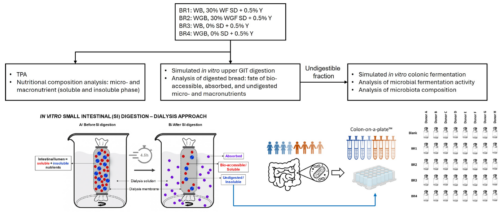In this study, the Lesaffre Institute of Science & Technology (LIST) in collaboration with ProDigest looked at the nutritional attributes of 4 bread recipes. The study analyzed :
- their nutritional composition
- in vitro gastrointestinal digestibility
- the effect on the metabolic activity and composition of the colonic microbiota of healthy adult volunteers.
“In addition to the digestibility of bread and the release of nutrients during digestion in the upper intestine, we know that the undigested fraction of bread can influence the human intestinal microbiome, which plays an essential role in health,” points out Nabil Bosco, Director of the Nutrition, Microbiota & Health Centre of Excellence.
By combining the expertise of 2 technological platforms, the first on Campus to simulate the initial stages of digestion as they pass through the upper gastrointestinal tract, and the second in collaboration with ProDigest (Belgium, Colon-on-a-plate® technology), the teams investigated the digestibility and colonic fermentation of 4 bread recipes made on Campus from :
- sourdough and white flour
- sourdough and wholemeal flour
- yeast and white flour
- yeast and wholemeal flour.
“After simulating digestion in the upper gastrointestinal tract, all the breads analyzed demonstrated good digestibility, carbohydrates and proteins and the release of micronutrients (vitamins and minerals) components of the bread. Colonic fermentation revealed changes in the composition of the intestinal microbiota, with significant increases in short-chain fatty acids and a significant decrease in short-chain branched fatty acids with all breads“, emphasizes Nabil Bosco.
This particularly interesting work fills the current lack of data describing bread’s in vitro digestibility and colonic fermentation, which are important aspects in fully characterizing bread’s nutritional profile and potential.
“Due to its cost, availability and high level of consumption, bread made from wheat flour is an excellent nutritional vector at the base of the food pyramid. This is why our research is currently focused on amplifying the nutritional benefits of bread while preserving its flavors“, emphasizes Céline Monnet, Director of the Baking Science & Nutrition Center of Excellence.
To find out more, read the full article:
Martinez Tuppia, C.; Rezaei, M.N.; Machuron, F.; Duysburgh, C.; Ghyselinck, J.; Marzorati, M.; Koper, J.E.B.; Monnet, C.; Bosco, N. In Vitro Human Gastrointestinal Digestibility and Colonic Fermentation of Wheat Sourdough and Yeast Breads. Foods 2024, 13, 3014.

A summary of the study’s methodology
BR = bread recipe; Y = yeast; GIT = gastrointestinal tract; SD = sourdough; TPA = texture profile analysis; WB = white bread; WGB = wholemeal bread; WF = wheat flour; WGF = wholemeal flour.


